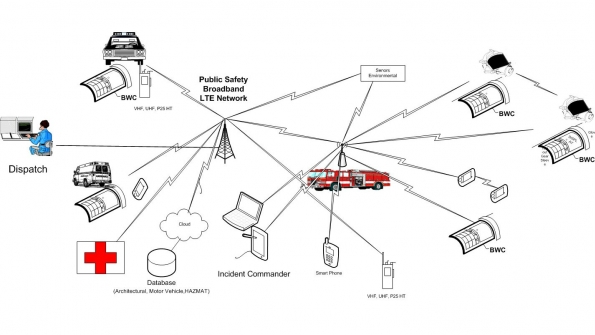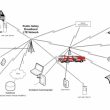Future First Responders and FirstNet: Response to a multiple-vehicle accident (MVA) scenario
What is in this article?
Summary
In the scenario described, a host of communication enhancements were identified with the purpose of improving situational awareness, as well as assisting in the preservation of life and property. We saw that fire or other first-response apparatus can operate as a cell site or standalone network using LTE. They used video and real-time telemetry, including tracking of assets and personnel for incident command and control, with the use of LTE and body-worn computer systems. These are similar to standard smartphones, but they are integrated in PPE and are Class 1 Division 1 devices.
Automatic capacity management for the wireless system was also discussed, using a tiered priority scheme within the public-safety network. The concept of using the commercial wireless networks to assist in capacity overload of the public-safety network following a tiered priority scheme to handle localized area also was advanced.
The first-responder community needs a standard set of applications for uniformity and function. Most of the applications discussed in the scenario put forth are either available today or can be implemented with existing technology. For example, BWCs are becoming more prevalent, leading to their adoption within the first-responder community.
A variety of applications and functions can—and will be—enabled by the public-safety LTE Network, resulting in a truly integrated response. The following applications and functions were covered in the scenario. A single asterisk has been placed next to the items that are not currently available but could be.
- Incident Commands (Fire Chief)
· Maintain situation awareness (Incident, Personnel, Apparatus, etc)
· Location awareness of all personnel (1 meter resolution) *
· Access to preplan data in a visual format, linked to dispatch
· Allocate and reallocate recourses as needed
· Communicate with other agencies (mutual aid)
· Hazmat information
· Send alerts to all or selected members in incident area
· Obtain news-footage feeds (not discussed)
· Prioritize and or reprioritize communication assets*
· Video feeds (streaming and Clips)
· EOC/911center status updates (automatic and user selected)*
- Fire Personnel
· Situation awareness
· Provide/Obtain real-time information, if needed, about mission in incident area (video and voice)*
· Fellow firefighter video feeds*
· Chemical interaction information (not discussed)
· Location of self and team members*
· Biometric data
· Sensor data (personal and telemetry source)
· Motor vehicle data (including barcode or VIN reading)
- EMS
· Situation awareness
· Provide/Obtain real-time information, if needed, about mission in incident area (video and voice)*
· Location of self and team members*
· Biometric data
· Sensor data (personal and telemetry source)
· Telemetry and video feeds to and from hospital/trauma centers (HIPAA Compliant)*
- Police
· Situation awareness
· Provide/obtain real-time information about mission in incident area
· Location of self and team members *
· Criminal database access
· Facial recognition
· Fingerprint scanning
· DMV records
- DPW
· Obtain/provide real-time information about mission in incident area*
· Obtain instructions for incident commander (non voice)*
- Public Utilities (Electric)
· Coordinate response with incident commander*
· Provide/obtain real-time information about mission in incident area*
- Commercial Wireless Networks
· Capacity offloading of the Public Safety system for peak demand in a localized area.*
In summary, the new LTE communication network can and will greatly improve response effectiveness by first responders. To take full advantage of the new LTE communication system, it is recommended that various standard operating guidelines used by first responders need to be enhanced, so this broadband network can be utilized to its fullest potential.
Clint Smith, P.E., is currently the CTO for Rivada Networks and has extensive experience in all aspects related to fixed and mobile wireless telecommunications, including senior management, system design, project management, budgeting, implementation, operations, and sales. A volunteer firefighter, he has been awarded multiple patents and has specific design and operational experience with LTE, CDMA/1xRTT/EVDO, GSM/GPRS/EDGE, WCDMA/HSPA, TDMA, iDEN, AMPS, LMDS, WiMAX, WiFi, PtP, and PSCS.
Acknowledgements:
This paper would not have been possible without the help and guidance from two of my Officers at the Pine Island Fire Department (PIFD) in Pine Island, N.Y.—PIFD Training Officer Fred Hroncich and PIFD Chief Pete O’Connor.











And the final scenerio, the
And the final scenerio, the chief receives a lawsuit on a stack of paper because he arrived on scene within minutes of it being reported and played on his tablet, messed with some electronics in the back of his SUV and played with a camera on the SUV while family members were left bleeding and dying. Just because we have all this technology that can do all kinds of neat and wonderful things doesn’t mean we should. Based on the story line given, it would seem that every resource, especially the chief’s vehicle should include an IT Technologist to run all of the stuff on board and keep track of all the data and information so the chief doesn’t work the scene with his nose pointed at a tablet. Does the chief really need to know that firefighter Jones is in the right rear seat of the second in engine? Does he need to know exactly when Jones stepped off the engine? If the chief doesn’t care about that minutiae I bet the lawyer will want to know.